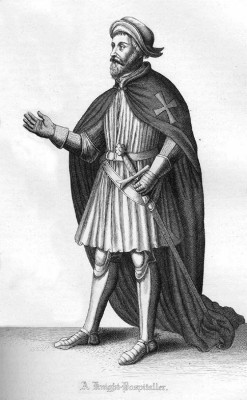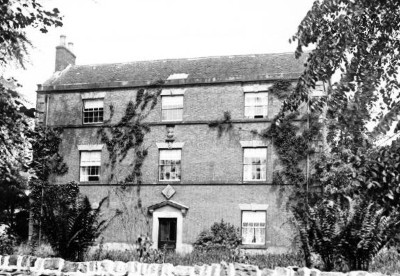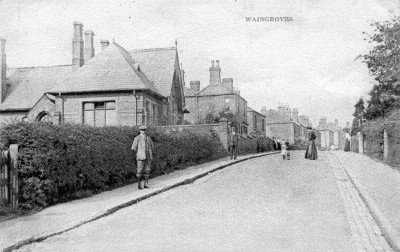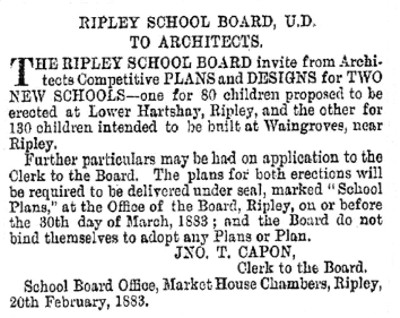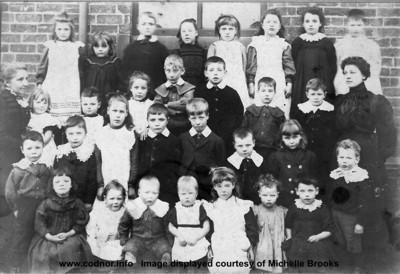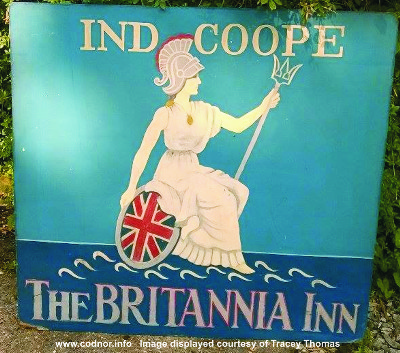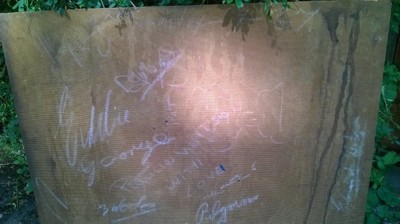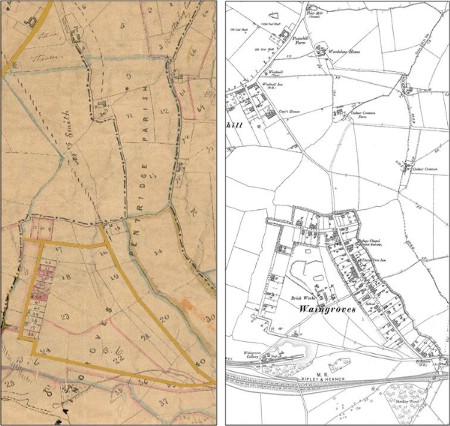Click Here to return to main page
The Village of Waingroves
Waingroves is a Derbyshire mining village that's been previously described as a Single road of houses, half a mile to the West of Codnor. However growth of the two villages during the nineteenth and twentieth centuries now sees them separated by only a single field’s width, and this is under threat from the need to build ever more houses.
The spelling of Waingroves as changed throughout history. The earliest example being Waingrif or Waingriff in 1147, later it was Wayngriff, Wayngreve or Wayngrene in the 1400s as well as Wingreayes before eventually settling on Waingrove then Waingrove’s and Waingroves
History
Ralph Fitz Stephen bestowed certain lands in Waingroves in the parish of Pentrich to the Knights Hospitallers of St. John of Jerusalem, around A.D. 1147, for a house of that order to be built .
The Knights Hospitallers
The Knights Hospitallers at Waingroves were part of an Order of knights who’s origins trace back to the building of a Hospital in Jerusalem dedicated to St. John the Baptist around AD 1092.The purpose of the Hospital was to provide care and protection for pilgrims travelling in the holy land.
They later built Precetories throughout England and although they were granted land at Waingroves for this purpose, no records exist of a Preceptory being built there.
Some disagreements arose between the Knights Hospitallers and the canons of Darley abbey over the use of the land.
In 1191 it was settled that the abbey should allow the Hospitallers to hold Waingrove in perpetuity of them, but that the tenant of the Hospitallers should hold common rights for his cattle, both in the wood and in the plain, only in proportion to the tenants of the abbey; that he should keep no pigs except his own, and that those should not exceed twenty; and that he should keep no goats unless they were also kept by the abbey tenants.
It was stipulated in the agreements that the rights of the mother church of Pentrich should be fully respected, and it was also arranged, in return for these concessions, that the Hospitallers should pay to the abbey an annual sum of 5s., within the octave of St. Michael
Further mention of Waingroves appears in John Pym Yeatman’s book “The Feudal History of the county of Derby” published 1886
Hundred Rolls of Edward I
In 1274 The Hospitallers hold in Wayngriff, 13 bovates of land, from what time is unknown.
In 1390. Sir Nicholas Montgomery gave to the Abbot of Derley(Darley) several lands and tenements in Ripley, Codnor, Waingriff and Derby
1st June 1410. Westminster. Patent Roll, Henry IV
Licence, for 10 marks paid in the hanaper by the abbot and convent of Derley, for Nicholas Mountegomery, chivaler,' Roger Leche, ' chivaler,' Robert Fraunceys, ' chivaler,' John Cokayn the elder,Peter de Melburn, Peter de la Pole and William de Babyngton to grant to them in mortmain a messuage, 7 bovates of land and 6 acres of wood in Ryppele (Ripley) and Wayngreve (Waingroves), held of the prior of St. John of Jerusalem in England by the service of 10s. yearly, an acre of land in Codenore; not held of the king, and 1 1/2 acres of land in Derby, held of the king in free burgage; for the prior and
brethren of the Hospital to release to them the said yearly rent of 10s.; and for them to re-grant to the said prior and brethren a yearly rent of 10s. from the said messuage, bovates of land and wood.
In 1423, Nicholas Montgomery, Clerk, and others gave to the Abbot and Convent of Derley certain lands, &c. in Derby, Rippeley, Wayngrene
Waingroves Hall 1890 image © Copyright Len Wood
Photo made
available by Picturethepast.org.uk, and licensed for reuse under this Creative Commons Licence
Waingroves Hall
It is generally
accepted that the original Waingroves hall was built in 1671 on the site of a
medieval manor house (or possibly Preceptory) most likely belonging to the
Knights Hospitallers. Medieval foundations were found in the front Garden of
the hall by one of its owners.
The first Hall was built for the son of Richard Clayton also called Richard and his wife Alice, but this is thought to have been severely damaged by fire in the early 1700s. The hall eventually came to William Strelley by marriage and it was the Strelley family who were responsible for much of the remodelling of the hall in the late 1700s early 1800s. The top floor windows have keystones decorated with the Sun, Moon and Owl and a diamond shaped date stone above the door inscribed SRE 1800.
The last of the Strelley family was Clayton Somerville Strelley and his daughter married Charles Haslam who is recorded as living there in 1895.
Frederick Channer Corfield also lived there for a short while whilst building Ormonde Fields House at Codnor.
Another resident
was Thomas Farnsworth 1912, Followed in the 1920’s by Col.H.J.A. Banks, then S Camplion Wright and also
Capt. Thomas Grieve. Laurie MC, who was the owner that indicated buried remains
of an earlier building existed beneath the front garden. Another owner who also took a keen interest
in the history of the hall was Dr. Gerald FitzMaurice Keatinge and his wife
Margaret. Doctor Keating was doctor to the Butterley Company and he suggested
that the current building was possibly the third or fourth incarnation of the
hall.
They had a son,
John Charles Fitzgerald Keating, who was a Lieutenant in the Irish Guards, but
he was killed in France in the Second World War.
The hall was later owned by a Mr & Mrs Lloyd, and sold for £68000 in 1982 to Mr and Mrs Philips.
Waingroves School
Waingroves School was built in 1884 and provided education for the village children for almost 100 years until it was regarded as surplus to educational requirements and was adopted as the Waingroves Community Centre in 1984.
Click this link to visit the Waingroves Community Centre website
Left: A postcard of Church Street Waingroves in the early 1900s. The school is in the foreground on the left.
Many thanks to Alfred Simpson for this photograph.
The following is a timeline of events that led to the building of Waingroves village school.
November 1878The Education Department have issued a final order giving notice that if school accommodation for 80 children at Hartshay, and 60 girls and infants at Waingroves is not supplied, or is not in course of being supplied within a period of six months, they will cause a school board to be formed for the United school district of Ripley and Pentrich November 1879
The Butterley company had done nothing with regard to school accommodation at Waingroves and therefore a school board would be forced upon the town. January 1883
The new School Board agrees to erect schools at Waingroves and Hartshay. Provision is to be made for 130 children at Waingroves and 80 at Hartshay. The population of Waingroves being 458 of which 129 are children. There are 84 children at Hartshay.
A model plan is to be solicited from the Education Department in London and Mr A.C.Peake, solicitor was appointed legal agent to the board
September 1883
The
Ripley School Board receive the following list of tenders and amounts for the
erection of schools at Hartshay and Waingroves
Messrs Frost and Son, Basford Notts £1181 7s 2d
W Clarke, Ripley, £1260
W Wilton, Ripley, £1317 10s
J Glossop, Ambergate, £1349
S Walker, Wirksworth, £1370
W.B Askey, Matlock, £1380 7s 7d
W Clewer (could be Clower) Ripley, £1419
J Fletcher, Ripley, £1446
W Manners, Ilkeston, £1500
T Warren, Derby, £1516
Mr J Kent of Derby, the architect certified in favour of the work done by Messrs Frost and Son and their tender was accepted.
November 1883A plot of land has been acquired from Mr E Farnsworth of Codnor for the building of Waingroves school and a loan of £1684 7s 2d is taken out from the Public Works Loans Commissioners to pay for the erection of the two schools at Waingroves and Hartshay. The loan will be over forty years at an interest rate of 4%
April 1884
The
Ripley school Board appoint Mrs E.A. Hanlon as Mistress to Waingroves school at
a salary of £60 per year. The school is expected to open by the middle of May.
9th June 1884
Waingroves
school opens for the first time. 95 children are admitted to the school over
the next few weeks.
July 1885
The
Ripley School Board appoints Miss Searson of Codnor as assistant mistress at
Waingroves school at £30 per year.
110 children are on the register at Waingroves school, with an average attendance of 87.
Have you got any class photographs from Waingroves school that could be scanned and displayed on this Waingroves webpage?
If so please contact me at stuart@saint94.freeserve.co.uk
Waingroves School c1906
Three boys likely to be in this photograph are the brothers;Amos, Charles and Joseph Radford.
Mrs Radford was appointed caretaker of Waingroves school circa Feb 1896, wages were 5s 6d.
In May 1892, Miss Stanley was the assistant teacher.
Mrs Searson held a “subordinate position” at this time.
The Britannia Inn (Bottom Pub) Waingroves.
Previously situated at the bottom of Church Street just below the corner and now the site of a bungalow.
Some early Landlords include;
Thomas Birkin 1874
George Edward Cope 1891 - 1901
Samuel Orme Thorpe 1911
The Britannia was demolished due to damage caused by mining subsidence
Ripley Co-operative Society No. 21 Branch
In November 1899 the Building committee recommended the Council to pass a plan for the erection of a Co-operative store in Waingroves.The No. 21 Branch of the Ripley Co-operative Society opened in March 1900. The shop was situated on the corner of Jessop street (previously called High Street) and Church Street.
At the end of its first year’s trading, it had 70 members, this increased to 98 by the end of 1909 with sales reaching £3351. The building still exists but is now a residential house and none of the original shop façade remains.
You can see from this map of Waingroves from 1854 that there was very little housing. There are no houses on Church street apart from a row of cottages sideways on, where the road used to finish just above Jessop Street (then called High Street). This row of cottages are still there.
The length of Waingroves road along the top to Peasehill doesn’t yet exist. However building plots can clearly be seen on Queen street and this is most likely to house miners families for the Butterley company’s new Waingroves pit, which wasn't officially sunk until 1859.
This map shows how much the village as grown in the forty Seven years since the 1853 map.Houses have sprung up on both sides of Church Street, together with a Chapel and public house (ThornTree Inn) and ‘Beer Houses’ Jolly Colliers and Brittania.
You can see the first Brickworks that have been established in the middle of the village, taking advantage of the clay deposits just a foot below the surface.
Queen Street still appears to be sparsely populated, but look how it still extends over Pit Lane and down to the corner at the bottom right of the map to join on to Church Street.
there was already some mining activity in the early 1850s.
The map also shows the Windmill at the top of Peasehill and also Peasehill farm.
Also note that Pit Lane hasn’t yet been established.
You can also see that building activity as started near the top of Waingroves Road and Peasehill. The Windmill is still there but it is now joined by the Windmill Inn Public House. A row of six cottages known as the Cope’s houses can also be seen sideways on to the road. My Uncle Johnny used to live here and he still had gas lights in the late 1960s.
Waingroves Colliery
For information on Waingroves Colliey Click Here
WALTER BRIERLEY
Walter was born at 96 Waingroves road on 25th June 1900. He was the middle son of five brothers, who all worked down the pit. His father George worked as a winding engineman at Denby pit for forty-five years.
Walter attended Waingroves school until he was thirteen then went to work at Waingroves pit, first on the surface until a year later when he started working underground at the outbreak of the first world war.
He continued working at the pit during the day as well as attending continuation classes at Waingroves school until the strike of 1921.
During the strike the pit floods, and never re-opens.
Walter is unemployed for the first time until he manages to find another job at Denby Colliery. He goes on to marry Amy and they have a son John in January 1927, however it wasn’t long before he was laid of work again in 1931.
But during this time he had continued as best he could with his education. He won a Miners’ Welfare Scholarship to University College Nottingham and then twice wins the Arthur Markham Prize for writing by a miner. It was his experiences as an unemployed young man on the dole queue that led him to write what is generally considered to be his best novel “Means Test Man” in 1935. The book is a portrayal of a coal miner humiliated by the means test and the effects of unemployment on a sensitive mind, a cry of pain and outrage at the indignity of no longer having status or function in the community.
Other well known novels by Walter Brierley include:
Sandwich Man (1937),
Dalby Green (1938)
Danny (1940)
In 1936 Walter joined the Derby Education Authority as a welfare officer, were he worked until he retired in 1965. He died in 1972.
One of Walters earlier works was published in a book called Under Thirty, An Anthology by Michael Harrison. The book contains stories written by several authors before attaining their thirty first year. Walter submitted a story called “Transition” which describes a young boy’s last day at school and first day working down the pit. It is based on Walter’s own experience and he describes life in Waingroves and surrounding villages but changes the names slightly as he does in his other novels. For example Ripley becomes Pirley.
To read Walter's short story click on the following link: Transitions by Walter Brierley
There will be lots more added over the next few weeks including the following:
Waingroves Windmill
Waingroves pubs
Waingroves Brickyard
Information for this page was obtained from the following sources:
The History of the county of Derby; Stephen Glover published 1829
Monasticon Anglicanum; William Dugdale 1846
Camdens Brittania published 1842
The Feudal History of the county of Derby; by John Pym Yeatman’s published 1886
The Ripley & Heanor News; (various)
Derby Mercury (Various)
Jubilee History of Ripley Co-op 1860-1910
Under Thirty, An Anthology' by Michael Harrison http://www.archive.org/stream/underthirtyantho00harruoft#page/n5/mode/2up
Make a free website with Yola
